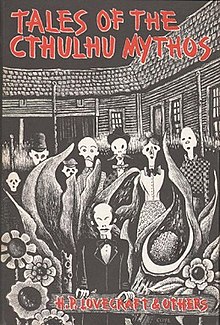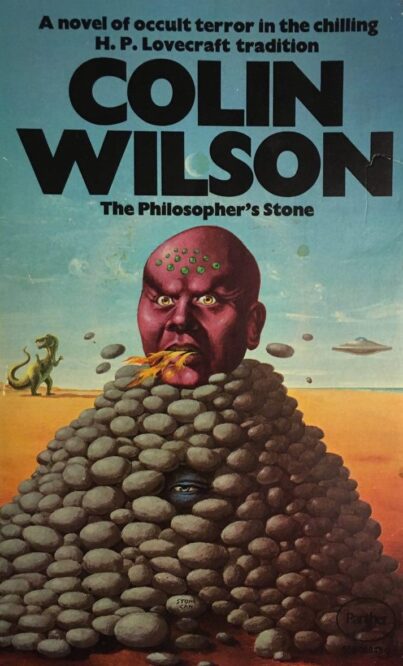H.P. Lovecraft is a controversial figure, to be sure, but an enduring one. Lovecraft’s shortcomings have in recent years been spot lit—George R.R. Martin, speaking at the 2020 Hugo awards, was pilloried merely for bringing up the man’s name—yet popular culture can’t seem to get enough of his work.
Lovecraft was indeed a racist (check out this lovely 1912 poem), as well as an admitted Hitler supporter and all-around misanthrope. Lovecraft scholars have grappled with these attitudes, and how they might have impacted his literary output, for decades; it could be (and has been) argued that Lovecraft doesn’t actually have fans, but rather apologists.
Yet Lovecraft’s writing permeates our culture, with updated editions of his fiction continually turning up (a snazzily designed collection of his complete works appeared the same year George R.R. Martin made that “controversial” name drop) in addition to a newly inaugurated HPL film festival and a plethora of HPL inspired films, books and games. The modern world may reject Lovecraft, but it can’t seem to ignore him.
The British writer/philosopher Colin Wilson (1921-2013) inspired a similarly ambivalent reaction. Wilson may not have been a racist or anti-Semite, but he was a highly contentious and outspoken figure. Among his major sins: he came from a working class background, lacked a university education, dubbed Shakespeare a “second-rate mind” and professed admiration for the notorious Ken Russell. Wilson claimed British reviews of his work often contained “A note of violence, as if my publishing a book were somehow a calculated affront” (the British critic David Pringle went so far as to compare Wilson to L. Ron Hubbard, a major insult in the UK).
Colin Wilson’s connection with H.P. Lovecraft’s work stretches back to 1961, the publication date of Wilson’s nonfiction tome THE STRENGTH TO DREAM. In it Wilson admitted HPL “possesses a gloomy imaginative power that compares with Poe,” but otherwise dismissed him as “a very bad writer” whose work is “finally interesting as case study rather than as literature.” Upon reading those words August Dereleth, Lovecraft’s biggest supporter (and/or apologist), fired off a letter to Wilson protesting his criticism and, bizarrely, challenging him to write his own Lovecraftian novel. A few years later Wilson had a change of heart about Lovecraft and accepted the challenge, with the resulting text, THE MIND PARASITES, published by Dereleth in 1967.
Wilson’s interest in HPL isn’t hard to fathom, as Lovecraft fully embodied the characteristics of the outsider, as detailed by Wilson in his iconic 1956 book of that name—this is to say that Lovecraft was a reclusive individual at odds with society, but who nonetheless exerted a considerable influence. I’d also opine that Colin Wilson found in HPL a kindred spirit, as many of Wilson’s own proclamations, such as the claim that “9 hundred 99 thousand, 99 people out of a million are all but hopeless,” could have emerged from Lovecraft’s mouth.
As with most of Wilson’s fiction, THE MIND PARASITES was frank and rather pedantic in its approach. Wilson admittedly had little interest in things like emotion and empathy, although, despite his claim that “I am neither original or creative,” he possessed a fertile imagination.
The opening pages are magnificently unnerving. They detail how the first person protagonist, an archeologist named Gilbert Austin, comes to the realization that his mind has been infected by parasites causing him to act against his own interests. This has come about through the excavation of an ancient Turkish city that Lovecraft dubbed Kadath.
The parasites have apparently been extant for centuries, but didn’t make their mark until the end of the eighteenth century. It was then, Wilson claims, that morbidity took hold of humanity, spearheaded by the Marquis De Sade (who sought “to add to the mental confusion of the human race”) and furthered by figures like the “life-slanderer” Schopenhauer and Adolph Hitler. How are we to combat all this negativity? Through the development of psychic powers in mankind, accomplished here by simply thinking really hard.
It’s all just as silly as it sounds, ricocheting haphazardly between hectoring philosophizing and a narrative that grows increasingly implausible. The novel is not uninteresting, however, wedding Lovecraft’s concepts with what Wilson identified as his lifelong obsession: “the paradoxical nature of freedom.”
That mixture was repeated with far greater skill in Wilson’s subsequent excursions in Lovecraftiana: the novel THE PHILOSOPHER’S STONE and the story “The Return of the Lloigor,” both of which appeared in 1969. In an introduction to THE PHILOSOPHER’S STONE Wilson mentions that “I had to write part of it as a separate short novel, which August Dereleth has published.” That short novel apparently took the form of “The Return of the Lloigor,” although the two narratives are distinct enough to be deserving of separate consideration.
“The Return of the Lloigor” was published in the Dereleth edited anthology TALES OF THE CTHULHU MYTHOS. Also contained were Lovecraft’s “Call of Cthulhu,” together with HPL inspired tales like Frank Belknap Long’s “Hounds of Tindalos,” Clark Ashton Smith’s “Return of the Sorcerer” and “The Shambler from The Stars” by Robert Bloch, with Wilson’s novella length effort being the collection’s longest entry.
Featured is an elderly professor named Paul Dunbar Lang investigating the Voynich manuscript, an actual centuries-old text written in a language that has yet to be deciphered by (it’s believed) a 13th Century Franciscan monk. Wilson’s highly audacious premise involves Lang figuring out how to translate the manuscript, which he concludes is a portion of the accursed NECRONOMICON.
The NECRONOMICON was an invention of Lovecraft, which is acknowledged by Wilson. But in the universe of THE PHILOSOPHER’S STONE Lovecraft is found to have known of an actual text which among other things told of the existence of the Lloigor, a prehistoric race of extraterrestrial beings that resided on the sunken South Pacific continent Mu, with human beings created to be their slaves.
Lang travels to the portion of Wales where the late Arthur Machen, one of Lovecraft’s major influences, lived. There Lang learns more about the Lloigor, who were weakened by living in a climate that was unable to sustain them and retired to the depths of the ocean. But it seems the Lloigor are about to return to the Earth’s surface, as indicated by increasing incidents of crime and destruction.
The story is impressive in its audacity and imaginative breadth, which lessen the annoyance of Wilson’s deliberate shunning of emotional response. As he wrote, “Mr. Osborne once said his aim was to make people feel. I think they feel too much. I’d like to make them stop feeling and start thinking.”
Which brings us to THE PHILOSOPHER’S STONE, surely one of Wilson’s magnum opuses and, according to some commentators, his finest novel. I don’t agree, but will concede that it’s the most ambitious of Wilson’s Lovecraft-inspired narratives.
As in “The Return of the Lloigor,” it features an elderly professor discovering the existence of an ancient race of Mu-dwelling monsters (identified here under Lovecraft’s preferred moniker The Old Ones), with the Voynich Manuscript once again a major element. Yet there’s far more to THE PHILISOPHER’S STONE, which appears to have taken Frank Belknap Long’s aforementioned “Hounds of Tindalos” as a major source of inspiration. Wilson replicates the structure of Long’s narrative, about a psychedelic time traveler discovering the existence of a race of malevolent interdimensional beings looking to do us in, albeit with a wholly unexpected inciting conception.
Viewers of the 2014 flick LUCY will recognize that conception, which is utilized far more intelligently here. The subject is the human brain, of which it’s been claimed that most of us only utilize a small portion; the unnamed narrator, whose background and temperament are virtually identical to those of Colin Wilson (characterization was never among his primary concerns), undergoes an operation that allows him to utilize a much greater portion of his brain, which sets him apart from his fellows (who “live on a level of emotional triviality”) and allows for mental time travel. The narrator can look at an object or painting, in other words, and directly experience its history.
The historical incidents include the construction of Stonehenge and an audience with Wilson’s nemesis Shakespeare, in which the popular theory that the Bard didn’t actually write any of the plays attributed to him is aired. It’s not until the second half that the Lovecraftian business occurs, in what Wilson fan Joyce Carol Oates called “a plethora of fanciful detail that would do justice to a genuine madman’s vision.” This makes for a somewhat disjointed narrative that begins in an optimistic manner but turns horrific, which coupled with the fact that the narrator’s musings frankly don’t read like those of a person operating at full brain capacity (1968’s CAMP CONCENTRATION by Thomas M. Disch offers a far more credible science fictional depiction of an expanded consciousness) results in a not-entirely-satisfying read.
Other, less overt Colin Wilson authored exercises in Lovecraftian speculation occurred in the enjoyable SPACE VAMPIRES (1976), in which extraterrestrial beings that may or may not be our distant ancestors drain peoples’ life essences, and the SPIDER WORLD quartet (1987-2003), set on a future Earth in which humans are enslaved by giant spiders (not unlike Wilson’s conception of the Lloigor and their treatment of early man). THE MIND PARASITES, “The Return of the Lloigor” and THE PHILOSOPHER’S STONE, however, constitute a unique trio that ranks among the most significant examples of Lovecraftian fiction (together with DAGON by Fred Chappell, MIDNIGHT SUN by Ramsey Campbell and the D.M. Mitchell edited STARRY WISDOM). All, despite their respective flaws, are highly recommended.





